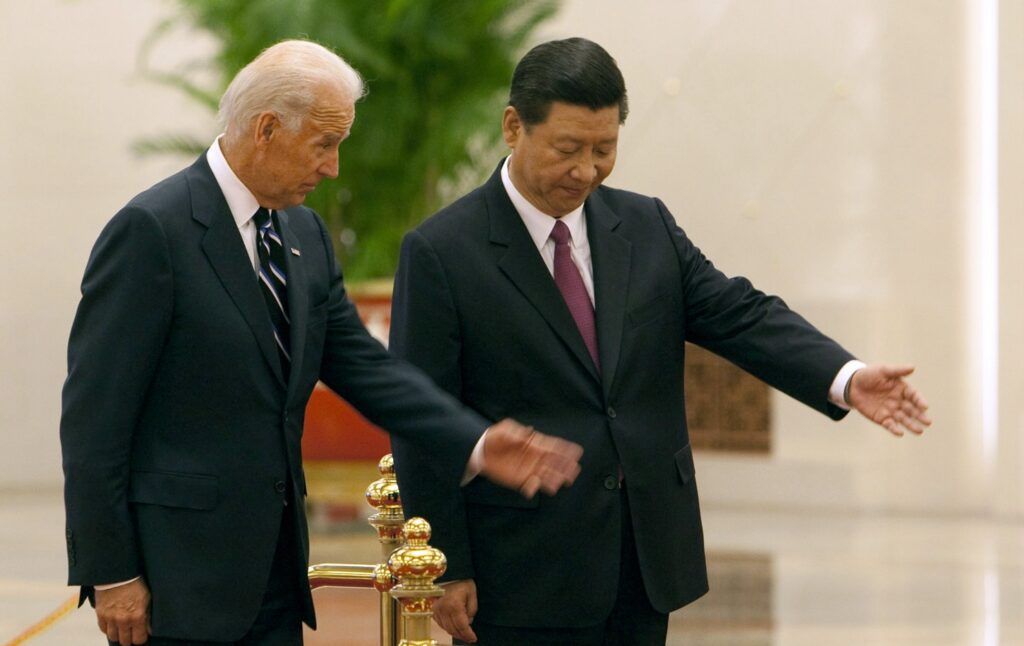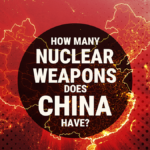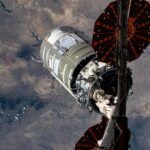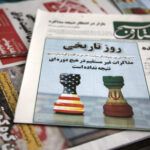Why a substantive and verifiable no-first-use treaty for nuclear weapons is possible
By Li Bin | June 4, 2024
 Then-Vice Presidents Xi Jinping and Joe Biden at the Great Hall of the People in Beijing in August 2011. (Nelson Ching/Bloomberg via Getty Images)
Then-Vice Presidents Xi Jinping and Joe Biden at the Great Hall of the People in Beijing in August 2011. (Nelson Ching/Bloomberg via Getty Images)
Since conducting its first nuclear detonation in 1964, China has pledged to never be the first to use nuclear weapons and has urged other nuclear weapon states to make the same commitment by proposing that they negotiate a no-first-use treaty.
In the United States, there have also been domestic policy initiatives, including in 2017 when US Vice-President Joe Biden commented that “deterring—and if necessary, retaliating against—a nuclear attack should be the sole purpose of the US nuclear arsenal.” However, successive US administrations have failed to formally adopt a “sole-purpose” policy, nor have they responded positively to China’s no-first-use proposals. And there is little hope that President Biden will move forward with this policy before the US presidential election in November.
But silence is consent: Both presidential candidates, Biden and Donald Trump, need now to explain to their domestic and international audiences why the United States should not adopt the “sole-purpose” policy and why they refused as presidents to negotiate a no-first-use treaty with China.
Criticism. The “sole purpose” and “no-first-use” policies may differ in some details, but in general they are very similar (and I don’t distinguish between the two here). There are two sets of reasons for criticizing the idea of no-first-use. First, for some, a no-first-use policy is not considered credible or verifiable. Others argue that the United States must retain the option of first use of nuclear weapons and that a no-first-use policy is not in the United States’ interest. This second argument, however, should be judged and debated by US experts and lawmakers.
In the United States, critics of the credibility of the no-first-use policy see two shortcomings. The first is that, in their view, China’s commitment may not be real. For example, the US Defense Department’s latest report on China’s military power lists several scenarios in which China might supposedly be the first to use nuclear weapons. The Defense Department explained at an October 2023 briefing that the US concern comes from “some of their openly published military literature and articles by Chinese scholars.” But this should not be a reason for the United States not to agree to engage in talks with China on the no-first-use issue. On the contrary: If China’s proposals or practices on the issue are not good enough, the United States could push China to improve its policies through mutual exchanges. In the case of nuclear transparency, for example, the United States appears to be not satisfied with China’s policy, but it has never given up pushing China to accept and implement the US definition of nuclear transparency. Put another way, the issue is not whether China is doing a good job or not on no-first-use, but whether the United States is ready to engage in serious talk about the issue.
Another argument for criticizing the no-first-use policy is that such commitments have inherent credibility problems because they are not verifiable. This, at least on the face of it, seems a serious issue. But it’s a problem only because it misunderstands the meaning of verification.
Arms control verification is about detecting violations of commitments and ensuring compliance. For example, verification of the Comprehensive Nuclear Test Ban Treaty (CTBT) involves monitoring nuclear explosive tests by states parties. Verification of a no-first-use treaty should be designed to detect any first use of nuclear weapons. Such verification should be technically much simpler than verification of other treaties, such as the Chemical Weapons Convention (CWC). The latter requires finding evidence of chemical weapons attacks and attackers, and sometimes such attribution can be difficult. Still, these difficulties did not prevent the CWC from being negotiated, concluded, entering into force, and functioning. Verification of a treaty of no-first-use of nuclear weapons is not more difficult and should not be an obstacle to its realization.
The real difficulty with a no-first-use treaty lies in the early warning of some non-compliance. There is a fear that a state party to the treaty could suddenly abandon its commitment and become the first to use nuclear weapons. Some nuclear experts have expressed that they do not have sufficient confidence that their countries can predict and respond to the sudden abandonment of the no-first-use commitment by an adversary.
Building confidence. To address doubts about credibility, a no-first-use treaty could—and should—incorporate concrete elements. By including confidence-building measures, the treaty would be more substantive than mere symbolism or political posturing.
First, the posture of a country’s nuclear forces may reflect its plan to use nuclear weapons first. Some nuclear weapons are better suited for deterrence, while others are better suited for battlefield operations against conventional weapons. If a country develops and deploys nuclear weapons that are suitable for battlefield operations, it indicates that its no-first-use commitment is not serious. This means that nuclear force posture can be used as an indicator to build confidence in a no-first-use treaty. One concrete example is nuclear landmines. These devices face a “use-it-or-lose-it” dilemma during a conventional attack and are therefore more likely to be first-use nuclear weapons. Another example is neutron bombs, low-yield thermonuclear weapons designed to maximize neutron radiation while limiting blast power. These weapons can be used to attack conventional forces on the battlefield and are therefore also possible first-use nuclear weapons.
A no-first-use treaty should ban nuclear landmines, neutron bombs, and other similar nuclear weapons to build confidence in no-first-use commitments. A ban on such weapons could include verification arrangements, so a no-first-use treaty aligns with the New START Treaty and the CTBT.
Second, some characteristics of nuclear forces may raise suspicions and concerns about possible first use of nuclear weapons that a no-first-use treaty could help states parties express and clarify. Nuclear-weapon states may view that the development or deployment of nuclear forces by other countries as an indication that they are lowering their threshold of nuclear use. They might be concerned about whether low-yield nuclear warheads are more likely to be used first, about the relationship between the size of strategic nuclear forces and the incentives to use nuclear weapons first, or about the relationship between the launch readiness of nuclear forces and first use.
There is currently no working platform or mechanism among the nuclear-weapon states to address these concerns. A no-first-use treaty—or even talks about or the negotiation of such a treaty—could play a communicative role in reducing suspicions about possible first use of nuclear weapons by those states. Such exchanges of views and concerns would be of substantial importance to confidence-building efforts to the negotiation and implementation of a no-first-use treaty.
Third, a no-first-use treaty could prohibit verbal threats of first use of nuclear weapons by the governments and militaries of states parties. Threatening to use nuclear weapons first is a means of sending a coercive signal. Such threats can be a major cause of escalation of nuclear confrontation and constitute a dangerous nuclear risk that must be reduced. A no-first-use treaty can consider any verbal threat of first use of nuclear weapons as a violation that is not only harmful but also detectable. A clause prohibiting the threat of first use of nuclear weapons, if included in the treaty, is verifiable. With a no-first-use treaty in place, if a state party intends to threaten to use nuclear weapons first would mean it can only withdraw from the treaty or violate its no-first-use commitment, raising the cost of signaling a nuclear threat. In this way, a no-first-use treaty could play a significant role in nuclear risk reduction.
A no-first-use treaty that incorporates these arrangements would not only be substantive and verifiable, it would also help gain the confidence and support of the international community.
Many benefits. A no-first-use treaty can also guide domestic political and technical debates. The nuclear-weapon states have a wide range of military programs, some of which may strengthen no-first-use commitments and some of which may undermine them. State parties to a no-first-use treaty have responsibilities to shape their military force structures to be consistent with no-first-use commitments. In domestic debates, political and technical experts and policymakers could invoke the treaty’s rules in support of projects that are consistent with the spirit of the treaty and against those that violate it. A no-first-use treaty could reduce the nuclear risks associated with the blind development of nuclear weapon projects by guiding domestic discussions in states parties.
A no-first-use treaty could also steer international debate and therefore contribute to establishing and strengthening the norm of no first use of nuclear weapons. In fact, there has been no use of nuclear weapons since the end of World War II. To explain this, one theory claims that mutual nuclear deterrence has prevented the incentives for first use, while another argues that it is the existence of a “nuclear taboo” that has limited the incentives for first use. This means that there is a social force that inhibits the first use of nuclear weapons. Whether this social force is a very strong—or a less strong but still useful tradition—remains subject to debate. But there is little doubt that a no-first-use treaty would strengthen this social force.
Opponents to a no-first-use treaty on nuclear weapons should remember what happened with chemical weapons. For nearly seven decades, the United States has been able to maintain its position and policy of no-first-use of chemical weapons after the Geneva Protocol banning the use of chemical and biological weapons was concluded in 1925. Some countries joined this treaty with the reservation that they would keep their right to retaliate, but their actual position was not to be the first to use chemical and biological weapons. It’s insightful to remember that the United States had the same position, with President Franklin Roosevelt saying in 1943: “I state categorically that we will not resort to the use of such [biological and chemical] weapons under any circumstances unless they are first used by our enemies.” The United States maintained this position of no-first-use of chemical weapons until late in the negotiations for the Chemical Weapons Convention, a treaty that would prohibit any use of chemical weapons and was concluded in 1992.
This history shows that no-first-use is not a mere symbolic gesture but can be a practical policy. Today, the United States remains committed to upholding global norms against the use of chemical weapons.
An equally-practical policy of no-first-use of nuclear weapons could consist of a main treaty body with additional protocols, as is the case with the Convention on Certain Conventional Weapons concluded in 1980. The main treaty body would establish principles and basic requirements, whereas the protocols would deal with specific issues such as nuclear landmines, neutron bombs, and the prohibition on threat of first use of nuclear weapons. These protocols could be negotiated on a case-by-case basis and then added to the package.
The current—and next—US administration and policymakers should respond positively to China’s initiative to negotiate a no-first-use nuclear weapons treaty to advance arms control developments, reduce nuclear risks, and enhance global security in a cooperative manner.
Together, we make the world safer.
The Bulletin elevates expert voices above the noise. But as an independent nonprofit organization, our operations depend on the support of readers like you. Help us continue to deliver quality journalism that holds leaders accountable. Your support of our work at any level is important. In return, we promise our coverage will be understandable, influential, vigilant, solution-oriented, and fair-minded. Together we can make a difference.















